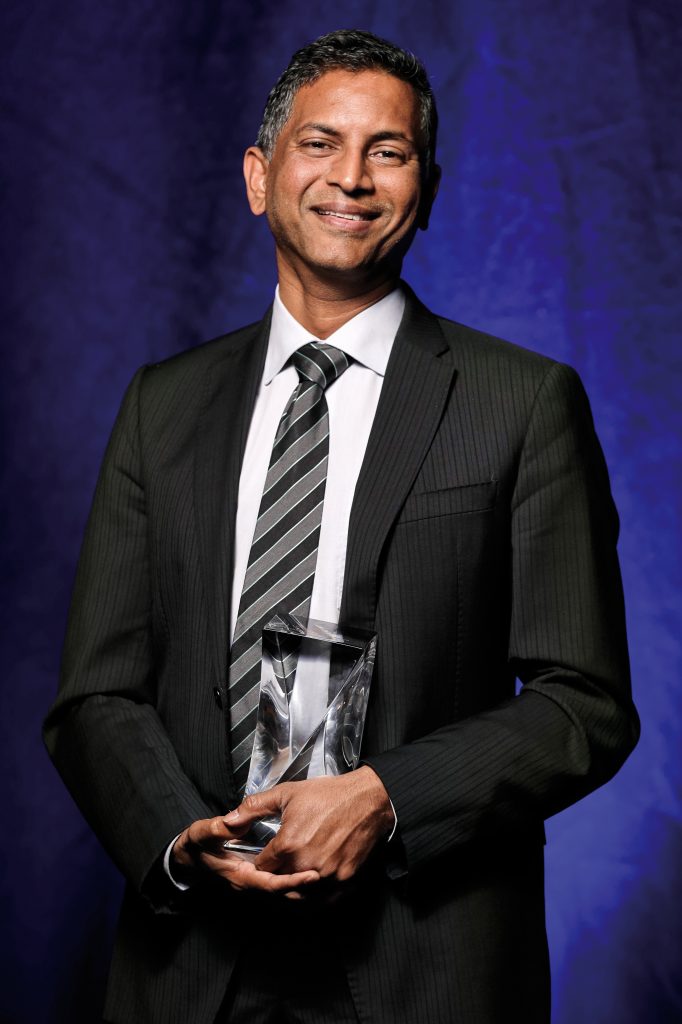New twists on old techniques
Winning video describes a new technique for improving the surgeon’s control in DMEK

Roibeard O’hEineachain
Published: Friday, December 6, 2019
 Chandrashekar Balachandran overall winner in the ESCRS Video Competition
Chandrashekar Balachandran overall winner in the ESCRS Video Competition
The overall winner of the 2019 ESCRS Video competition was Chandrashekar Balachandran, Australia, for “The DMEK kite”. Accompanied throughout by amusing and illustrative animations, the presentation describes a new technique for improving the surgeon’s control in placing the donor tissue in Descemet’s membrane endothelial keratoplasty (DMEK) procedures. It involves using a novel Descemet’s punch for creating Descemet’s button with a 1.0mm by 3.0mm tail and a 7.0mm diameter centre. The graft is pulled through the eye by its tail, which is left in place in the corneal incision during the opening and unrolling, centring and air-bubble-assisted placement of the tissue.
DIFFICULT AND SPECIAL CASES
Lucio Buratto, Italy, took first prize in the Difficult and Special Cases category for “Cataract surgery in eyes with previous radial keratotomy”. In the video he provides tips on the precautions necessary to achieve optimal visual results and avoid dehiscence of the radial keratotomy.
Fathy Morkos, Italy, received second prize in the same category for “Vision Rescue in an Eye Scheduled for Evisceration”. Amar Agarwal, India, received third prize for “Ocular masquerades”.
EDUCATIONAL
In the Educational category, Jiří Cendelin, Czech Republic, won first prize for “Cataract surgery in case of damaged or lost capsular bag”. Using a large eye model and surgical videos, Dr Cendelin demonstrates the use of scleral tension rings, equatorial iris hooks, iris-fixated IOLs and scleral fixation of IOLs in eyes with compromised or absent capsular bags.
Vasavada Shail, India, received second prize in the Educational category for “Posture perfect: ergonomics for the ophthalmic surgeon”. Third prize went to Hisaharu Suzuki, Japan, for “Creation and Evaluation of Complication Models Using Slit Side View Cataract Surgery”.
HISTORICAL
In the Historical category, Georgios Balanikas, Greece, took first prize for “Imaging and depiction in ophthalmology throughout the centuries”. His video highlights the development of the art of anatomical illustration and its contribution to the growth of scientific understanding and surgical practice in ophthalmology.
Robert Osher, USA, received second prize for “The zonular challenge: history and evolution” and Lional Raj Daniel Ponniah, India, received third prize for “Herbal Magic – A Superluminal Anesthetic Ethnomedicine”.
INNOVATIVE
Tushya Om Parkash was awarded first prize in the Innovative category for “Outcome of pupillary zone sparing partial corneal epithelium debridement for collagen cross linking (C3R) in keratoconus”. It describes outcomes with a new collagen cross-linking (CXL) method designed to achieve the pain reduction and more rapid visual rehabilitation of epi-on CXL, yet maintain the superior efficacy of conventional epi-off CXL.
Timothy Page, USA, received second prize for “Make the Turn without the Burn: A Critical Analysis of CTR Insertion and a Novel Injector System to Reduce CTR Complications”.
SCIENTIFIC
Sheetal Brar, India, received first prize for “Boost that SMILE: Enhancing the “WOW” factor with Small Incision Lenticule Extraction”. The video describes the theory and practice of optimising femtosecond laser settings and lenticule extraction in SMILE® procedures in order to provide patients with more predictable postoperative refractive correction and a more rapid visual recovery.
Diana Carmen Dragnea, Romania, received second prize for “In vitro evaluation of the Feasibility of Slit-lamp Nd:YAG-laser Descemetorhexis”.
RESIDENT IN TRAINING
Jerónimo Riera, Argentina, received first prize in the Resident in Training category for “How do we mark the eye for a successful Toric IOL alignment in just one step”. Chaudhary Rahil received second prize for “Posterior Polar Cataract- how to be safe as a resident”.